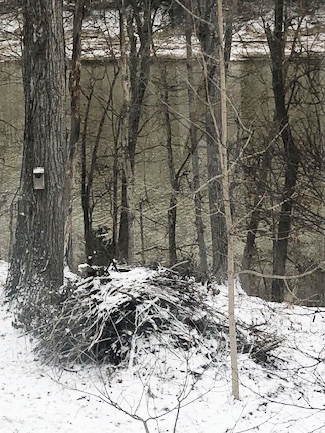The red oak tree in our wooded backyard had been there for decades. It stood looking over Herrington Lake and every year was a host to birds and caterpillars of many species. A piliated woodpecker visited it regularly and barred owls hooted from its branches at night. It was a treasure and an important part of the natural, native environment that we have allowed and encouraged. And then it died last year, suddenly with little warning. It was not close to our house and was not falling apart onto other trees. What to do? Our arborist, Jason McKinney, who loves naturalized gardening, said it was a hardwood which could stand for some time. It was obvious he was not anxious to cut it down. And so, we decided to leave it, at least for a while, and see what would happen. Last spring, there it was, 50 feet tall, still towering over the trees nearby, but its leaves and its shade were gone – though other shorter trees helped fill in the spaces. The wildflowers sprung to life and bees flocked to the Virginia bluebells, mayapples, foam flowers, wood poppies and wild columbines that were encouraged by a bit more sun. A two-foot tall tulip poplar that had planted itself a few years ago began to grow with abandon. It even had two blooms for the first time. Small maples also began to grow. A bald eagle lit in the top of the dead tree during a hard rain and stayed there for almost 30 minutes, too soaked to fly. And, magically, the first hummingbird of the season came to the columbines, touched every bloom, then flew onto the tip of a bare branch and rested there between sips of nectar. By fall, we were so very happy with our decision to let nature care for itself. Color was provided by the red leaves of the Virginia creeper that quickly took possession of the dead trunk. The red and sugar maples growing behind the tree were now much more visible. Wood asters and zigzag goldenrods that had languished there for 13 years were happy in less dense shade and covered by small skipper butterflies and tiny bees. The hummingbirds were gone but other migrating birds were everywhere and could now be observed easily. A screech owl took up residence in a hole near the top of the trunk. And that tulip poplar was taller than myself and would keep growing. The words “Leave It Be” come to mind every time I gaze at our old friend. I can’t wait to see what treasures the red oak will bring in the future. Life goes on and, in its dying, the tree became a beacon for those that were left behind.
Lake and every year was a host to birds and caterpillars of many species. A piliated woodpecker visited it regularly and barred owls hooted from its branches at night. It was a treasure and an important part of the natural, native environment that we have allowed and encouraged. And then it died last year, suddenly with little warning. It was not close to our house and was not falling apart onto other trees. What to do? Our arborist, Jason McKinney, who loves naturalized gardening, said it was a hardwood which could stand for some time. It was obvious he was not anxious to cut it down. And so, we decided to leave it, at least for a while, and see what would happen. Last spring, there it was, 50 feet tall, still towering over the trees nearby, but its leaves and its shade were gone – though other shorter trees helped fill in the spaces. The wildflowers sprung to life and bees flocked to the Virginia bluebells, mayapples, foam flowers, wood poppies and wild columbines that were encouraged by a bit more sun. A two-foot tall tulip poplar that had planted itself a few years ago began to grow with abandon. It even had two blooms for the first time. Small maples also began to grow. A bald eagle lit in the top of the dead tree during a hard rain and stayed there for almost 30 minutes, too soaked to fly. And, magically, the first hummingbird of the season came to the columbines, touched every bloom, then flew onto the tip of a bare branch and rested there between sips of nectar. By fall, we were so very happy with our decision to let nature care for itself. Color was provided by the red leaves of the Virginia creeper that quickly took possession of the dead trunk. The red and sugar maples growing behind the tree were now much more visible. Wood asters and zigzag goldenrods that had languished there for 13 years were happy in less dense shade and covered by small skipper butterflies and tiny bees. The hummingbirds were gone but other migrating birds were everywhere and could now be observed easily. A screech owl took up residence in a hole near the top of the trunk. And that tulip poplar was taller than myself and would keep growing. The words “Leave It Be” come to mind every time I gaze at our old friend. I can’t wait to see what treasures the red oak will bring in the future. Life goes on and, in its dying, the tree became a beacon for those that were left behind.
Linda Porter
